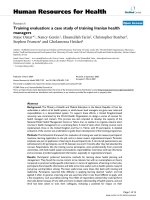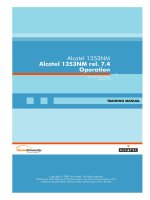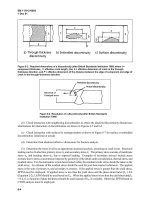Package Evaluation Training 7 sealingwindow
Bạn đang xem bản rút gọn của tài liệu. Xem và tải ngay bản đầy đủ của tài liệu tại đây (677.67 KB, 15 trang )
26/09/2012
Package Evaluation
T i i
Training
Sealing window
PE-07/2012-04-01
Agenda
1. Introduction
2. Transversal Sealing (TS) window
3. Longitudinal Sealing (SA/LS) window
PE-07/2012-04-01 / 2
1
26/09/2012
1 IIntroduction
1.
t d ti
Sealing window
PE-07/2012-04-01
Introduction
Seal in Tetra Pak Packaging System
Front Panel
Transversal
Sealing
(TS)
SA
strip
s
LS
Longitudinal
Sealing
(LS)
External Sealing layer
Primer
Strip Applicator
Sealing
(SA)
Internal layer, usually PET
Rear Panel
Primer
External Sealing layer
PE-07/2012-04-01 / 4
2
26/09/2012
What is a sealing window (SW)?
Just softening/overheating PE ≠ sealing it
This statement is effective for all sealing technologies (IH; HA; US; CH)
►
A SW is the range of energy required to have an acceptable
sealing quality, starting from
a lower limit = first setting giving a good sealing decreasing the
energy the sealing gets blocked
to
an upper limit = last setting giving a good sealing increasing the
energy the sealing gets overheated
Applicable for Transversal sealing (TS), Longitudinal sealing (LS), Strip
Applicator (SA), PullTab (PT),…
►
The optimum is defined by the medium value of the range.
PE-07/2012-04-01 / 5
What is a sealing window (SW)?
Example of LS sealing, hot air
Sealing window is
from 180 ◦C to
290 ◦C, medium
value is 235 ◦C
Medium setting, 50%
is recommended to
use in production
PE-07/2012-04-01 / 6
3
26/09/2012
SW: When is it required?
►
►
►
►
►
►
New filling machine installation
New production capacities
New type of product (different viscosity, %fat, fibre, etc…)
Product temperature change (impact on TS)
Trouble shooting
Etc…
Basic Requirements:
1.
2.
3.
Filling Machine perfectly set following MM
Test methods
Trained personnel
PE-07/2012-04-01 / 7
2. Transversal sealing
window
i d
Sealing window
PE-07/2012-04-01
4
26/09/2012
Transversal seal : Induction heating
Sealing jaw : Inductor
Pressure jaw : Dollies, Cutting rails, Knife, Spring, Rubber Bushing
PE-07/2012-04-01 / 9
Transversal seal evaluation
Tearing
PE-07/2012-04-01 / 10
5
26/09/2012
Transversal seal evaluation
Dissolving
PE-07/2012-04-01 / 11
Transversal seal evaluation
Dissolving - Heat pattern evaluation
Note:
For 6 mm fin package
(TBA 80,100B, 125S);
B-measurement is
acceptable when > 0
mm
PE-07/2012-04-01 / 12
6
26/09/2012
Transversal seal evaluation
Dissolving - Red ink tightness
PE-07/2012-04-01 / 13
TS sealing window
TPIH 2000 - 2500
The setting
g range
g determined by
y the test is only
y valid in the
conditions during the test and not as general working range
for the filling machine.
► If any comparison test need, it is necessary to run at the test
same occasion and with the same conditions.
► Filling machine must set according to MM and EM, the
settings of the jaw system, e.g. parallelism, are an important
parameter to assure the final result of the activity.
► Verify the conditions of the cutting rails and inductors,
inductors mount
new dollies.
► Check the cooling water flow through the inductors (for two
jaws machine).
►
PE-07/2012-04-01 / 14
7
26/09/2012
TS sealing window
Test Execution - General
After machine ready in Production state, make a preliminary
test to find the power setting of the TPIH unit for
cold/blocked seal.
► Run machine with the found value for about 5 minutes in
order to stabilize all temperatures.
► Run at least 100 packages before collect packages sample.
► Then increase the power setting by 10 scu or 25 watt for
every trial until the upper limit found (plastic lumps,
overheating swinging package).
overheating,
)
►
Note: Increase power setting can be 20 scu or 50 watt on middle
value but not at the lower of upper part.
PE-07/2012-04-01 / 15
TS sealing window
Test Execution – 2 jaws machine
► At
each setting take out 10 packages (5 LH and 5 RH)
► Evaluate 2 LH and 2 RH packages (total = 4 packages per
setting) immediately with the stretch pliers, note the seal
quality in the test report
►Once
the range is defined, take 1 LH and 1 RH (total = 8
packages) at the lower, middle, ¾ and highest setting to be
dissolved
Highest
g
setting
g
3/4 setting
Middle setting
Lower setting
PE-07/2012-04-01/ 16
8
26/09/2012
TS sealing window
Test Execution – Chain machine
► At
each power setting take out total 20 packages (2
packages per link). Make sure each package is marked with
link number.
► Evaluate 4 packages immediately with the stretch pliers,
note the seal quality in the test report
► Once the range is defined, take out 1 sample per link (total
=10 packages) at the medium setting and evaluate
immediately with the stretch pliers to verify the uniformity of
th sealing
the
li quality
lit among allll th
the lilink.
k
►Once the range is defined, take 1 sample per each link (total
= 40 packages) at the lower, middle, ¾ and highest setting to
be dissolved.
PE-07/2012-04-01/ 17
TS sealing window
Documentation
Record P-order and reel no.
Record Filling machine information
Record product and temperature
► Record all settings
► Attached form as example
►
►
►
Microsoft Excel
Worksheet
PE-07/2012-04-01/ 18
9
26/09/2012
3. Longitudinal
S li window
Sealing
i d
Sealing window
PE-07/2012-04-01
Longitudinal seal (LS)
SA
LS
PE-07/2012-04-01 / 20
10
26/09/2012
Longitudinal seal evaluation
Heat distribution zonoscope
PE-07/2012-04-01 / 21
Longitudinal sealing evaluation
Tearing
PE-07/2012-04-01 / 22
11
26/09/2012
Longitudinal seal evaluation
Ink injection to air gap
PE-07/2012-04-01 / 23
Longitudinal seal evaluation
Ink injection to air gap – Channel deviation
PE-07/2012-04-01 / 24
12
26/09/2012
LS sealing window
Hot air/Induction heating
The setting
g range
g determined by
y the test is only
y valid in the
conditions during the test and not as general working range
for the filling machine.
► If any comparison test need, it is necessary to run at the test
same occasion and with the same conditions.
► Verify conditions, alignment and setting of hot air
elements/inductor, spring pressure according to MM, mount
new LS pressure roller.
► Check the overlap dimension and overall forming of the
package produced, overlap and forming should be on
package basic condition.
►
PE-07/2012-04-01 / 25
LS sealing window
Test execution
► After
machine ready in Production state, make a preliminary
test to find the power setting of the lower limit by tear down
method.
► Let the filling machine produce for 10 minutes before test
execution
►
Run at least 100 packages before collect packages sample
Then increase the power setting by 10 scu/C or 25 watt for
every trial until the upper limit found (blistering/swing packages)
►
► Hot air - Each setting read the temperature and air pressure
and note in the record, adjust pressure according to recommend
setting in MM when increase temperature.
PE-07/2012-04-01/ 26
13
26/09/2012
LS sealing window
Test execution, cont…
► At
each setting take out 14 packages for evaluation
►Evaluate
by manual tearing 4 packages for each setting
►Evaluate
10 packages each setting by red ink injection to
air gap, record the result in the test report
► Use zonoscope to check heat distribution, constant heat
distribution along the seal length. For lower setting, heat
distribution should >2 mm from strip edge
edge.
► Induction heating, for upper part, the length of wrinkle
must be < 15 mm.
PE-07/2012-04-01/ 27
LS sealing window
Documentation
Record P-order and reel no.
Record Filling machine information
Record product and temperature
► Attached form as example
►
►
►
Microsoft Excel
Worksheet
PE-07/2012-04-01/ 28
14
26/09/2012
E d
End
Sealing window
PE-07/2012-04-01
15









